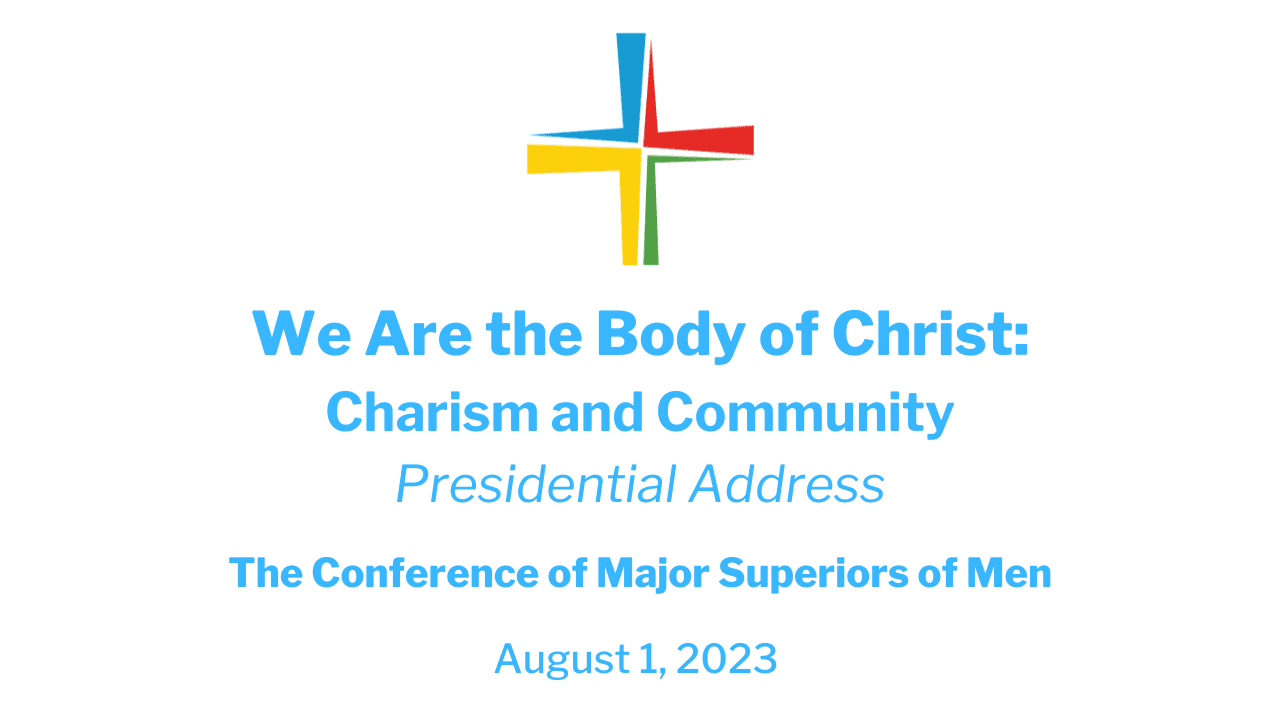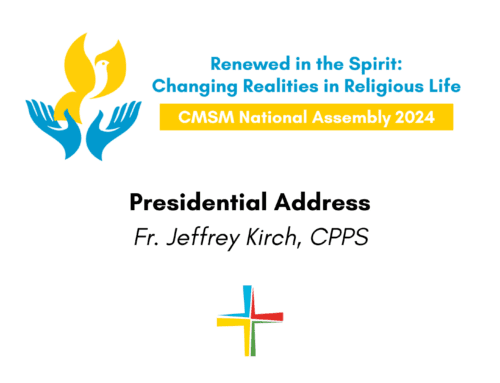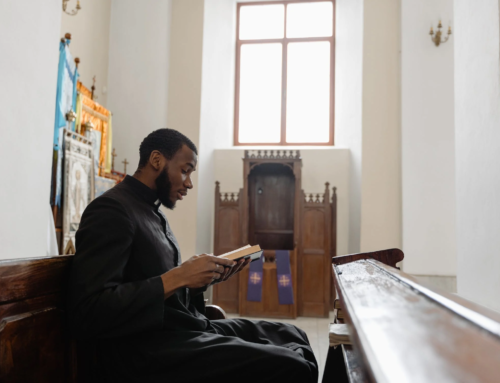Review for Religious is pleased to publish a copy of the Very Rev. Jeffrey Kirch, CPPS’s Presidential Address to the 2023 Assembly of the Conference of Major Superiors of Men. In his address, Fr. Kirch contextualizes some of the major issues male religious are facing today, hones in on charism as a resource for dealing with those issues, and broadens his insights by connecting them to the thought of Pope Francis on religious life.
Click here to download a copy of the essay.
On behalf of the CMSM Board, Fr. Frank Donio, the Executive Director, and our staff I want to welcome you to our 2023 National Assembly. Thank you for taking time from your busy schedules to gather here in Kansas City to continue to build relationships with your fellow brothers in leadership. Sharing fraternity is a hallmark of religious life and I know I look forward to sharing time with you, to share stories, and to truly learn from one another. Much work has gone into the planning of the assembly and we have a great line-up of panel discussions. Our theme this year is “We are the Body of Christ: Charism and Community.” I would like to use our theme to frame this brief address. I will do this in three movements. First, I want to begin by noting the current context of leadership in religious life today. Second, I will argue that attention to our charism is vital in our role as leaders and can be a resource for us in our ministry. And third, I will offer some concluding remarks on Pope Francis’ vision of religious life.
Leadership
All of us gathered here have some role to play in leadership. We wear a variety of hats. We are a pastor at times; at other times, a disciplinarian. We have to be a fundraiser and a building manager. We are the head of an HR department and a counselor. Because we do wear so many hats we can find it difficult to keep up. At times it might feel as we are just treading water. At times, pastoral projects are stagnant or move forward slowly due to your time and energy being taken up by everything piling up on the desk.
The recent CARA survey of major superiors commissioned by the Conference of Major Superiors of Men, the results of which will be presented later in the Assembly, point to a number of issues which major superiors are faced with. For example, 69% of CMSM members indicated that the aging of members was a top challenge and 64% highlighted a lack of vocations as a top challenge. 30% indicated that responding to lawsuits was very challenging. 63% said that excessive workloads are a major challenge. It is due to reasons such as these that some communities have difficulty finding members who are even willing to step up into leadership positions.
As leaders we are asked to deal with a variety of issues that can stress, strain, and
possibly even break us. Many communities in the United States are aging. As the demographics of a community changes we have to be able to adapt. How do we manage our eldercare? As demographics change how do we ensure that our sponsored ministries will continue to be guided by the congregation’s mission? How do we as leaders navigate the ever-changing world of safe-guarding, particularly in the area of adult misconduct? How do we as leaders negotiate our relationships with bishops? How do we as leaders ensure that our vocation efforts are successful?
Our lives as major superiors carry a significant amount of stress. If you are like me, then I am sure that on many occasions you have said to yourself, none of this is why I became a religious. Certainly as leaders we have the responsibility to ensure that our communities are functioning well, and this means attending to the legal, physical, financial, practical, and
personnel issues.
There is a danger that all of our time and energy will be consumed by these practical issues, and we end up neglecting what is at the heart of religious life, our charism and mission. Instead of neglecting our charism due to the stress and workload of leadership, I would argue that charism and community are actually resources we can call on to help us in our role as leaders. Let us turn now to examine more closely the relationship between charism, community, and leadership.
Charism and Community
Religious life has taken a multitude of forms throughout the history of the Church. The wide variety of communities gathered here are a testament to that. Each form of religious life—monastic, mendicant, societies of apostolic life, and institutes of consecrated life—arose within a specific context and their development was in part responses to the wider society in which they were born. Monastic communities formed after Christianity had become the religion of the Roman Empire and no longer a persecuted minority. Mendicant orders arose in the midst of the rebirth of urban centers. And societies of apostolic life primarily arose in the 19th century within the context of urbanization and colonialism. Each form of religious life was responding to the societal changes of their times. Each form of religious life, historically, sought to build up the Body of Christ by sharing their unique charism with the Church and world of the day.
Perfectae Caritatis from Vatican II called on all communities to “return to the sources of all Christian life and to the original spirit of the institutes.” [1] Just as the wider world of theology was “returning to the sources” so too the Council called on all communities to reimagine their founders’ charism within an ever-changing world.
A community’s charism is its life blood. It is the reason for its existence. That charism is intimately tied to mission and the role it plays in the Church and world. If the charism is no longer relevant, then one wonders how effective the community will be in its mission and in fact if the community will even survive. Sr. Patricia Wittberg, a Sister of Charity and sociologist, estimated that most religious communities have a life span of 200 years. [2] And Fr. Robert Schreiter, CPPS posited that two-thirds of the religious communities existing at the time of the Council of Trent no longer exist. [3] The great gift given to the Church from the Second Vatican Council was not so much a set of documents, though they are certainly important. The real gift was a spirit of ongoing renewal. The Council stressed the importance of constantly reading the signs of the times and in the process bring the Gospel to bear on those signs. This is ever more important during times of transition and change. Within the context of religious life today, which is marked by interculturality, intergenerational living— and in some cases diminishment—how do our communities not only stay faithful to our charisms but ensure that our charisms are effective for building up the Body of Christ? I would posit that if we cannot envision how our charisms are relevant in the world today individual communities will gradually go out of existence. The Church has been going through a significant time of transition for seventy-five years. We’ve changed emphases from a pyramid shaped institutional ecclesiology to a Pilgrim People of God. There was an explosion of lay ministry. Our liturgies have changed. The Church has had to grapple with changes in the wider society. We’ve been confronted with an increasingly secular world.
The abuse crisis has rocked the Church. These times of change, transition, and even upheaval can be difficult to deal with. Yet we as leaders in religious life are called to do just that. There are tremendous societal pressures on religious communities today. The stress of ongoing litigation related to clerical sex abuse, lack of vocations, an aging population, and financial concerns each make our ministry as leaders more difficult. But I would argue that those stressors, while certainly difficult to contend with, do not necessarily threaten the existence of a community. What is an existential threat to a community is losing sight of its charism and
mission.
While we do, as major superiors, need to deal with the practical elements of our ministry. We do need to keep an eye on the finances, legal issues, and demographics. But I would argue that as leaders our paramount role is as keeper of the charism. We are called to ensure that our charism lives in our hearts, in our members’ lives, and in the Church. It is through our lived charisms that we effect renewal within the Body of Christ and the world. It is through our lived charisms that the Holy Spirit renews the face of the earth. We are also called to respond to the daily challenges of leadership with our charisms. How does your charism help you to respond to the challenges of leadership? In addition to individually bringing our charism to bear on our ministry of leadership, we are also called to help our brothers in community understand how our charisms are a resource to respond to the challenges posed by our ministry. The genius of the Second Vatican Council and the subsequent renewal of the Church and religious life was dual movements of a return to the sources and a creative adaptation in a changing world. Perfectae Caritatis states, “The adaption and renewal of religious life includes both the constant return to the sources of all Christian life and to the original spirit of the institutes and their adaption to the changed conditions of our time.” [4] These two movements go hand in hand. As leaders we are called to hold our communities accountable to our very identity which is manifested through our charism. When we do not live through our charism, we are not being who Christ has called us to be. We end up in an identity crisis that will lead to breakdown in a variety of ways.
In addition to being true to our charism, we have to respond to the environment we find ourselves in. If we want to ensure that our charism is effective, we have to know and understand the world as it is, not as it was or as we want it to be. This is not a case of changing our charism to make it suitable for the world. We are called to scrutinize the world and apply our charism in the most appropriate way so that it can be a catalyst for renewal. If we as leaders do not keep our primary focus on our charism then we will be overwhelmed by the weight of our office and all of the accompanying tasks. Clearly the Church is in a time of change. And our ministry needs to be able to address that change. Our communities are changing too. The large cohorts of members ordained or professed in the 1950s are disappearing. In many of our communities, Hispanic members are growing in number. Local communities could have three different cultures under one roof. Even the language of our congregations are changing. It is our role, as leaders, to help our members navigate these changes while staying true to our charisms and way of life.
Pope Francis: Mission and Charism
Change and development seem to be two hallmarks of Pope Francis’s pontificate. Women will be voting members of the upcoming Synod. The Roman Curia has been reorganized and somewhat modernized. The Church has steadily turned its attention to the Global South which is experiencing tremendous growth. With all of this change and development at the Roman level, there is certainly risks. Does the Holy Father have too many “irons in the fire”? Is there some sort of idea that is guiding this development? Are these changes effectively responding to the signs of the times? I believe that the answer to these questions can be found in Francis’s vision of religious life. Recently the Holy See announced that in conjunction with the Holy Year in 2025 there will be a Jubilee of Consecrated Life as well. This jubilee will be spread over three years and will include events in both home countries and in Rome. The jubilee will be marked by three themes:listening to the cry of the poor, protection of the environment, and solidarity of the human family. In the run up to the jubilee celebration there will be many opportunities to reflect on religious life. But we do not need to wait until then to get an understanding of Francis’s vision
for religious life.
On November 21, 2014, Pope Francis released an Apostolic Letter “On the Occasion of the Year of Consecrated Life.” This letter offers us a succinct presentation of his understanding of religious life. In his letter the Pope lays out a blueprint not only for the Year of Consecrated Life, but really a plan for his papacy and his understanding of the role of religious life in the Church and the world. At the very beginning of his letter he urges those in religious life “‘to wake up the world’, since the distinctive sign of consecrated life is prophecy.” [5] Religious life as a whole has a charism, a distinctive sign, and that is prophecy. And the role of prophecy is to wake up the world—wake up the world to the presence of God; wake up the world to the Gospel. Religious life is not alone in this mission. It is important to note that the Pope proclaimed the Year of Consecrated Life on the occasion of the 50th anniversary of the promulgation of Lumen Gentium, the Dogmatic Constitution on the Church. Religious life has a distinctive role to play in “waking up the world,” and within that role, each of us has a distinctive role which we express through our charisms.
But Francis wants to be clear that the whole Church has a responsibility for this mission. The entire Body of Christ is an agent of change. Religious life is not something separated from the Body of Christ. Religious life is a constitutive part of the Body of Christ. It has a distinct role to play and is not somehow tangential to the wider Church. Just as all the baptized are called to be priest, prophet, and king, yet the ordained have a unique ministry, so too with religious life and the Body of Christ. Within the Body of Christ, religious have a unique role, again a charism. Conveniently Francis frames his reflection chronologically, he offers the Church three aims for the Year of Consecrated Life. First, we are to “look to the past with gratitude” (YCL, 1). He says that all of our communities are “heir to a history rich in charisms” (YCL, 1). Our founders were called by the Holy Spirit to address the needs of the world in a specific way and “respond creatively to the needs of the Church” (YCL, 1). As the times changed, our congregations matured and developed. By looking at our history, by returning to the sources, we are in fact “preserving our identity” (YCL, 1). We see how the charism has led to a creativity that is effective across time. We are also called to “live the present with passion” (YCL, 2). In this we listen to how the Holy Spirit calls us to be faithful to the Gospel and our particular way of living the Gospel today. Francis writes, “The Year of Consecrated Life challenges us to examine our fidelity to the mission entrusted to us. Are our ministries, our works and our presence consonant with what the Spirit asked of our founders and foundresses?” (YCL, 2). He is asking religious to engage in a perpetual examination of conscience. We should always be asking ourselves, “Are we being faithful to our mission?”
He offers us a sort of common charism for all religious. He stresses that religious are called to become “experts in communion” (YCL, 2) in order to build up the Body of Christ through our unique way of life. He stresses the importance of this due to the fractured condition of our world. “In a polarized society, where different cultures experience difficulty in living alongside one another, where powerless encounter oppression, where inequality abounds, we are called to offer a concrete model of community by acknowledging the dignity of each person and sharing our respective gifts, makes it possible to live as brothers and sisters” (YCL, 2). His third aim is to embrace the future with hope. He asks us to embrace the future with hope. As the CARA study demonstrates, there are challenges in religious life today. This is especially true for us as leaders. We are called to respond to these challenges with hope. Francis argues that this hope is not grounded in good statistics related to the number of vocations or financial resources. Instead, our hope is grounded in “the One in whom we have put our trust (cf. 2 Tim 1:2), the One for whom ‘nothing is impossible’ (Lk 1:37)” (YCL, 3). He warns us to not “yield to the temptation to see things in terms of numbers and efficiency, and even less to trust in your own strength” (YCL, 3). Finally, it is worth quoting him where he writes, “I urge you not to ‘join the ranks of the prophets of doom who proclaims the end or meaninglessness of the consecrated life in the Church in our day’…Let us constantly set out anew, with trust in the Lord” (YCL, 3). Finally, Francis’ vision of religious life is intimately tied to his call to go to the peripheries and “wake up the world.” He writes in the apostolic letter, “Come out of yourselves and go forth to the existential peripheries. “Go into all the world…a whole world awaits us: men and women who have lost all hope, families in difficulty, abandoned children, young people without a future, the elderly, sick and abandoned…” (YCL, 4).
Conclusion
There is an old saying that the only constant in life is change. I think the life of the Church, and specifically religious life demonstrates this. Yet the change is not just for change. And the change can not be just rearranging the chairs on the Titanic. We as congregations change because we desire for our charism to be as effective as possible in the world. Our role as leaders in our congregations is keep that charism in front of our members. It is to continually test our charism to ensure it is being effective. It is our responsibility to develop our charism as situations warrant. It is our responsibility to see that the charism that has been gifted to us by the Holy Spirit is kept strong and alive. None of these are easy tasks. Especially when coupled with lawsuits, buildings, investment portfolios, difficult bishops, and an aging membership. But thankfully we have our brothers in community to support us. We have our charism to guide us. We have the Holy Spirit to inspire us.
[1] Perfectae Caritatis (October 28, 1965), 2,
https://www.vatican.va/archive/hist_councils/ii_vatican_council/documents/vat-ii_decree_19651028_perfectae-caritatis_en.html.
[2] Patricia Wittberg, SC, The Rise and Decline of Catholic Religious Orders: A Social Movement Perspective (Albany, NY: State University of New York Press, 1994.
[3] Robert Schreiter, CPPS, “Reimagining Consecrated Life in a Changing World” (lecture, Catholic Theological Union, Chicago, IL, February 12, 2015).
[4] Perfectae Caritatis, 2.
[5] Francis, “On the Occasion of the Year of Consecrated Life,” November 21, 2014, 2,
https://www.vatican.va/content/francesco/en/apost_letters/documents/papa-francesco_lettera-ap_20141121_lettera-consacrati.html (hereafter YCL).






